The Metric System
Important dates in the history of the modern metric system (S.I.):
1670 metric system originated on about this
date. Gabriel Mouton, a French vicar
1792
The U.S. Mint was formed to
produce the world'sfirst decimal currency (the U.S. dollar consisting of 100 cents).
1866 The use of the metric system made legal
(but not mandatory) in the United States by the Metric Act of 1866 (Public
Law 39-183). This law also made it unlawful to refuse to trade or deal in metric quantities.
1975 The Metric
Conversion Act of 1975 (Public Law 94-168) passed by Congress. The Act
established the U.S. Metric Board to coordinate and plan the increasing
use and voluntary conversion to the metric system. However, the Act was devoid
of any target dates for metric conversion.
1979 BATF requires wine producers and
importers to switch to metric bottles in seven standard [liter and milliliter]
sizes.
1983 The meter is redefined in
terms of the speed of light by the 17th CGPM, resulting in better precision but
keeping its length the same.
1988 The Omnibus Trade and
Competitiveness Act of 1988 amended and strengthened the Metric
Conversion Act of 1975, designating the SI metric system as the
preferred measurement system, and requiring each federal agency to be metric by
the end of fiscal year 1992.
1991 President George Bush signed ExecutiveOrder 12770, Metric Usage in Federal Government Programs directing all
executive departments and federal agencies implement the use of the metric
system. The Executive Order is also available as an appendix to: Interpretation
of the SI for the United States and Federal Government Metric Conversion Policy
1994 The Fair
Packaging and Labeling Act (FPLA) was amended by the Food and Drug and
Administration (FDA) to require the use of dual units (inch-pound AND metric) on
all consumer products.
1996 As of July 1996 all surface
temperature observations in National Weather Service METAR/TAF
reports are now transmitted in degrees Celsius.
2001 April 09 U.S. Stock Exchanges changed
to decimal trading. The Securities
and Exchange Commission has ordered that all stocks must be quoted in
dollars and cents rather than fractions by this date. The switch to decimal
trading brought the U.S. in line with the rest of the world's major exchanges.
This follows the change of the Canadian Stock Exchanges to decimal trading in
1996.
One of the principal advantages of the Metric System is its use of only one
unit (standard of size) for each parameter (thing that is being measured). The
metric units are interrelated in such a way that only seven fundamental standards
are necessary. These fundamental standards are identified with an * in the
tables below.
The 7 Standard Metric Units
Second
- time
kilogram - mass
degrees kelvin - temperature
meter - distance
kilogram - mass
degrees kelvin - temperature
meter - distance
candle
(candela) - light
ampere
- current and resistance
mole
- amount of substance
MECHANICS
|
Parameter:
|
Metric
Unit
|
English
Units
|
|
time
duration, delay |
second *
s |
second,
minute
hour, day |
|
frequency
|
Hertz
1/s |
cycle
per second
|
|
length
distance, displacement |
meter
1/299 792 458 light sec m |
inch,
foot, yard
rod, chain, furlong, mile |
|
velocity,
speed
rate of change of position |
meter
per second
m/s |
foot
per second
mile per hour, knot |
|
acceleration
rate of change of velocity |
meter
per second squared
m/s2 |
foot
per second squared
|
|
mass
quantity of material |
kilogram *
kg |
ounce,
pound, ton
|
|
force
push, pull, or weight |
newton
kg m/s2 |
pound-force
|
|
impulse
force times time |
newton
second
kg m/s |
pound-force
second
|
|
momentum
mass times velocity |
kilogram
meter per second
kg m/s |
pound
foot per second
|
|
work,
energy
force times distance |
joule
(pronounced "jewel")
= one newton meter kg m2/s2 |
foot
pound-force
|
|
power
rate of doing work |
watt
= one joule per second kg m2/s3 |
foot
pound-force per second
horsepower |
|
area
size of a surface |
square
meter
m2 |
square
foot, square yard
acre, square mile |
|
pressure
force per unit area |
pascal
newton per square meter kg/m s2 |
pound-force
per square inch
|
|
volume,
capacity
|
cubic
meter (stere)
m3 |
pint,
quart, gallon
cubic foot, cubic yard |
|
density,
heaviness
|
grams
per cubic centimeter
g/cm3 |
pounds
per cubic foot
|
HEAT
|
Parameter:
|
Metric
Heat Unit
|
English
Heat Unit
|
|
heat energy
|
joule,
calorie,
Calorie
1 cal = 4.186 joules 1 Cal = 4186 joules |
British Thermal Unit
|
|
temperature change
|
kelvin *
|
Fahrenheit degree
|
|
temperature
|
kelvin
|
degrees Fahrenheit
|
LIGHT
|
Parameter:
|
Metric
Light Unit
|
|
luminous intensity
|
candle *
|
|
luminous flux
|
lumen
one candle produces 4 pi lumens |
|
illumination
|
lux
lumen per square meter |
|
focus
|
diopter
reciprocal meters |
ELECTRICITY
& MAGNETISM (There are no English electrical units)
|
Parameter:
|
Metric
Electrical Unit
|
|
electric charge
|
coulomb
96,500 coul = 1 faraday faraday = 1 mole of electrons |
|
electromotive force (EMF)
|
volt (joule per coulomb)
|
|
capacitance
|
farad (coulomb per volt)
|
|
electric current
|
ampere (coulomb per second)
|
|
electric energy
|
joule (watt second)
(newton meter) KWH = 3,600,000 joules |
|
electric power
|
watt (joule per second)
|
|
electrical resistance
|
ohm (volt
per ampere)
|
|
electrical conductivity
|
siemens (coulomb per joule)
(ampere per volt) |
|
electrical field strength
|
volts per meter
|
|
electromagnetic inductance
|
henry (pl. henrys)
|
|
magnetic field intensity
|
oersted (formerly the gauss)
|
|
magnetic flux
|
weber (108 maxwells)
|
|
magnetic flux density
|
tesla weber
per square meter
|
|
magnetomotive force
|
gilbert
|
Each physical quantity (length, mass, volume, etc.) is represented by a specific SI unit. That unit is made larger or smaller by addition of a prefix to the stem unit.
Commonly used metric system units and symbols:
|
Type
of Measurement
|
Unit
Name
|
Symbol
|
|
length,
width, distance, thickness, girth, etc.
|
meter
|
m
|
|
mass (often
called weight)
|
kilogram*
|
kg
|
|
mass
(larger)
|
metric ton
|
t
|
|
time
|
second
|
s
|
|
temperature
|
degree
Celsius**
|
°C
|
|
area
|
square meter
|
m2
|
|
area (land)
|
hectare
|
ha
|
|
volume
(liquid or other)
|
liter
|
L***
|
|
volume
(larger)
|
cubic meter
|
m3
|
|
density
|
kilogram per
cubic meter
|
kg/m3
|
|
velocity
|
meter per
second
|
m/s
|
|
velocity
(autos)
|
kilometer
per hour
|
km/h
|
|
force
|
newton
|
N
|
|
pressure,
stress
|
kilopascal
|
kPa
|
|
energy
|
kilojoule
|
kJ
|
|
power
|
watt
|
W
|
*The gram (g) is the stem unit to which other prefixes are added.
**The kelvin (K) is the SI base unit of thermodynamic temperature.
***The capital el (L) is preferred as the symbol for liter in the USA; however the lower case el (l) also is correct and is used in many metric countries.
Derived Units
|
Force
|
newton
|
N
|
kg m s-2
|
|
Energy
|
joule
|
J
|
kg m2 s-2
|
|
Power
|
watt
|
W
|
kg m2 s-3
|
|
Frequency
|
hertz
|
Hz
|
s-1
|
|
Charge
|
coulomb
|
C
|
A s
|
|
Capacitance
|
farad
|
F
|
C2 s2 kg-1 m-2
|
|
Magnetic Induction
|
tesla
|
T
|
kg A-1 s-2
|
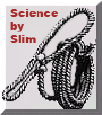 |
The Metric Prefixes |
|
Prefix:
|
Symbol:
|
Magnitude:
|
Meaning
(multiply by):
|
|
Yotta-
|
Y
|
1024
|
1 000 000 000 000 000 000 000 000
|
|
Zetta-
|
Z
|
1021
|
1 000 000 000 000 000 000 000
|
|
Exa-
|
E
|
1018
|
1 000 000 000 000 000 000
|
|
Peta-
|
P
|
1015
|
1 000 000 000 000 000
|
|
Tera-
|
T
|
1012
|
1 000 000 000 000
|
|
Giga-
|
G
|
109
|
1 000 000 000
|
|
Mega-
|
M
|
106
|
1 000 000
|
|
myria-
|
my
|
104
|
10 000 (this is now obsolete)
|
|
kilo-
|
k
|
103
|
1000
|
|
hecto-
|
h
|
102
|
100
|
|
deka-
|
da
|
10
|
10
|
|
-
|
-
|
-
|
-
|
|
deci-
|
d
|
10-1
|
0.1
|
|
centi-
|
c
|
10-2
|
0.01
|
|
milli-
|
m
|
10-3
|
0.001
|
|
micro-
|
u (mu)
|
10-6
|
0.000 001
|
|
nano-
|
n
|
10-9
|
0.000 000 001
|
|
pico-
|
p
|
10-12
|
0.000 000 000 001
|
|
femto-
|
f
|
10-15
|
0.000 000 000 000 001
|
|
atto-
|
a
|
10-18
|
0.000 000 000 000 000 001
|
|
zepto-
|
z
|
10-21
|
0.000 000 000 000 000 000 001
|
|
yocto-
|
y
|
10-24
|
0.000 000 000 000 000 000 000 001
|
Commonly used metric prefixes
|
Prefix
Name
|
Prefix
Symbol
|
Prefix
Value
|
|
| giga | G | 1 000 000 000 | 109 |
|
mega
|
M
|
1 million or 1 000 000
|
106
|
|
kilo
|
k
|
1 thousand or 1000
|
103
|
|
hecto
|
h
|
100
|
102
|
|
deka
|
da
|
10
|
10
|
|
|
|
|
|
|
deci
|
d
|
1/10 or 0.1
|
10-1
|
|
centi
|
c
|
1/100 or 0.01
|
10-2
|
|
milli
|
m
|
1/1000 or 0.001
|
10-3
|
|
micro
|
µ
|
1/1 000 000 or 0.000 001
|
10-6
|
|
nano
|
N
|
1/1 000 000 000 or 0.000
000 001
|
10-9
|
Some special relationships:
- 1 milliliter = 1 cubic centimeter
- 1 milliliter of water has a mass of approximately 1 gram
- 1 liter of water has a mass of approximately 1 kilogram
- 1 cubic meter of water has a mass of approximately 1 metric ton
Legal/official (exact) definitions of inch-pound units as set by U.S. law:
- 1 inch = 25.4 millimeters
- 1 pound = 453.592 37 grams (453.6 g)
- 1 gallon = 3.785 411 784 liters (3.79 L)
Approximate conversion factors between inch-pound units and the International System of Units (SI):
- Multiply inches by 2.54 to get centimeters (this conversion factor is exact)
- Multiply feet by 0.305 to get meters
- Multiply miles by 1.6 to get kilometers
- Divide pounds by 2.2 to get kilograms
- Multiply ounces by 28 to get grams
- Multiply fluid ounces by 30 to get milliliters
- Multiply gallons by 3.8 to get
liters
Some baseline temperatures in the three temperature scales
|
temperature
|
kelvins
|
degrees celsius
|
degrees fahrenheit
|
|
symbol
|
°K
|
°C
|
°F
|
|
boiling point of water
|
373.15
|
100.
|
212.
|
|
average human body
temperature
|
|
37.
|
98.6
|
|
average room temperature
|
|
20. to 25.
|
68. to 77.
|
|
freezing point of water
|
273.15
|
0.
|
32.
|
|
absolute zero
|
0.
|
-273.15
|
-459.67
|
Temperature conversions between the three temperature scales:
kelvin / degree celsius conversions (exact):
- kelvins = degrees celsius + 273.15
- degrees celsius = kelvins - 273.15
degree Fahrenheit / degree celsius conversions (exact):
- degrees F = degrees C x 1.8 + 32.
- degrees C = (degrees F - 32.) / 1.8
A degree celsius memory device:
There are several memory aids that can be used to help the novice understand the degree Celsius temperature scale. One such nemoic is:
When it's zero it's freezing,
when it's 10 it's not,
when it's 20 it's warm,
when it's 30 it's hot!
Or, another one to remember:when it's 10 it's not,
when it's 20 it's warm,
when it's 30 it's hot!
30's hot
20's nice
10's cold
zero's ice
20's nice
10's cold
zero's ice
Examples of everyday item equivalences for metric units of length, mass, volume, and temperature
(Drawings excerpted from the book, Quick Guide to the Metric System, by Valerie Antoine, USMA Executive Director)|
Length:
1 meter (1 m) |
 |
|
1
centimeter (1 cm)
|
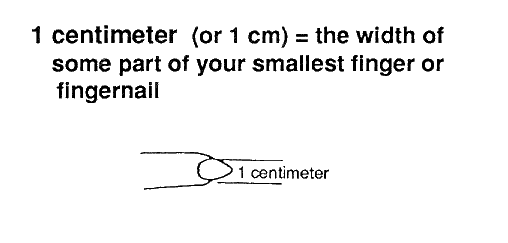 |
|
1
kilometer (1 km)
|
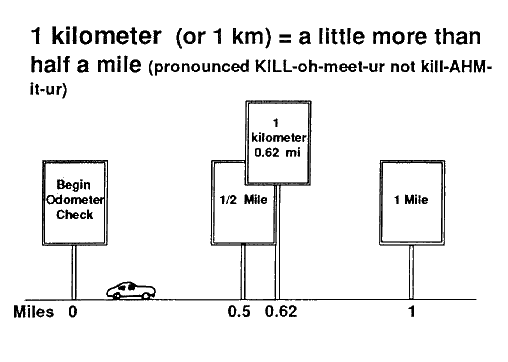 |
|
Mass:
1 kilogram (1 kg) |
 |
|
1
gram (1 g)
|
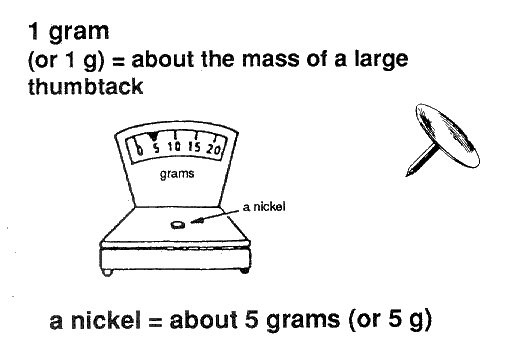 |
|
Volume:
1 liter (1 L or 1 l) |
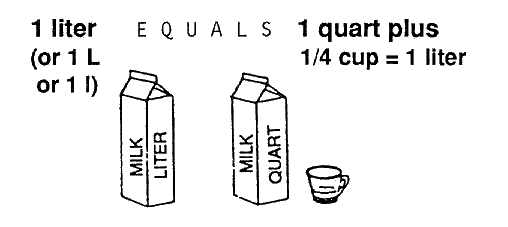 |
|
1
milliliter (1 mL or 1 ml)
|
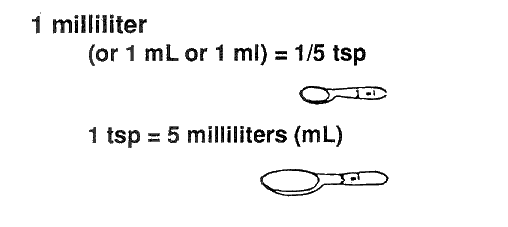 |
|
Temperature:
degree celsius (°C) |
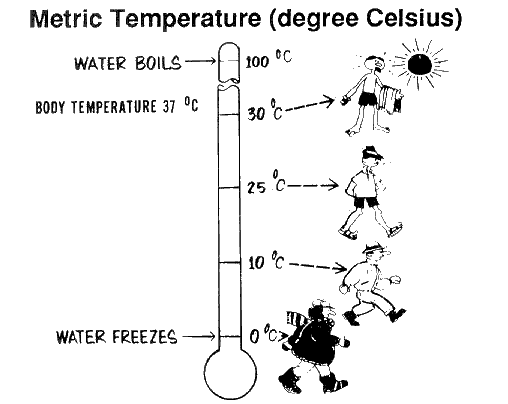 |
No comments:
Post a Comment